AR 15s, 1911s, and GLOCKs are hard to beat if you want a gun that’s easy to customize. They are three of the most popular firearm platforms in the world, and that’s apparent because these three guns are also the most common guns in the 80% world.
I’m sure most of you know how 80% lowers and frames work. By law, they’re not firearms, and don’t require a background check. But they require the end-user to finish them.
I got the bug to try to build my own 80% GLOCK, and a company called Polymer 80 makes an 80% GLOCK frame They’re quite inexpensive, and they even address my own complaints with the GLOCK grip.
I bought a PF940v2 full-size frame kit (the equivalent of a G17) and got to work.

I don’t want to dive too deep into the build process, as lots of videos already explain it a bit better than I can in text. I will say the process is very simple, and the tool requirements are minimal. I used a hand drill and a Dremel and mostly finished the build in a single night.
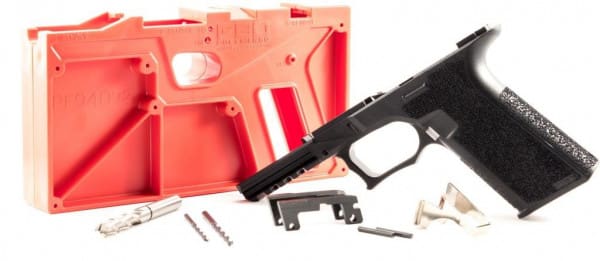
I say mostly because that’s when I had to begin refining the frame. This is where the files and sandpaper come out. After that, it’s just a simple installation of parts and pieces. The build process is simple, but there is some trial and error involved in getting everything running right.
Why Build a Polymer 80 GLOCK?
Admittedly building one of these guns isn’t much cheaper than just buying a GLOCK at your local gun store, especially when you compare it to LEO trade-ins. My purpose wasn’t a budget gun as much as it was building a gun for fun. It was a project and I saw the process as more or less a recreational activity.
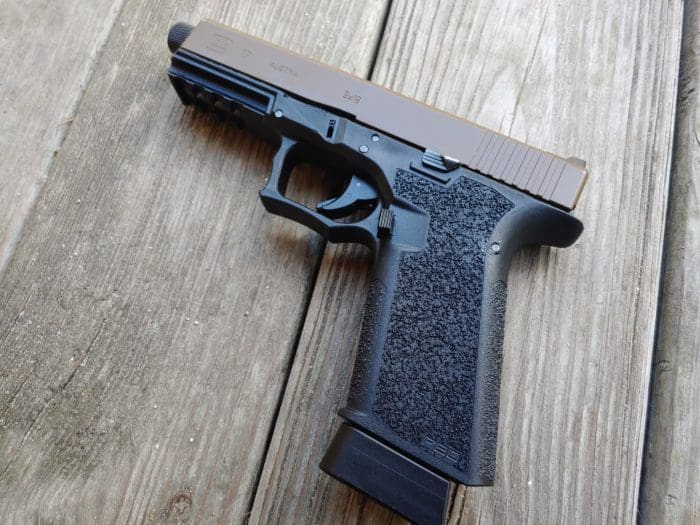
You can save a little money if you wanted to use non-standard GLOCK parts. What I mean is that while my Polymer 80 GLOCK cost almost as much as a standard Glock, mine is outfitted with a variety of upgrades at the same overall cost.
That leads me to my second reason, I can build a gun from the ground up, picking and choosing the parts I want.
Oh, and there’s one more advantage I should mention: no background check required.
How I Chose the Parts
I chose the full-size frame because I had no expectation of concealing it and full-sized guns are easier to shoot and handle for my 2XL-sized hands.
For the lower parts, I went with GLOCK OEM parts. I wanted to maximize reliability and these frames are built for GLOCK parts.
Aftermarket GLOCK parts are built for the standard GLOCK frame and while they may be compatible, I wanted to eliminate any weak points reliability-wise. I did invest in a kit with an extended slide stop and extended magazine release.
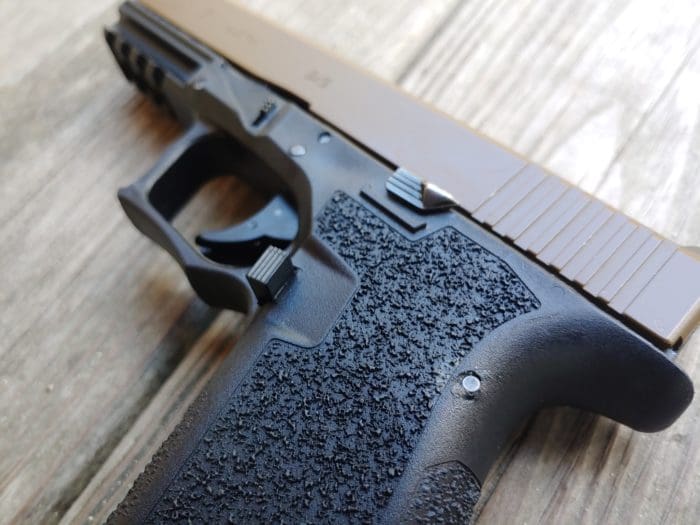
The barrel was actually one I already had and finally put to good use. It’s a Bear Creek Arsenal threaded 9mm barrel. It was my first experience with BCA products and I am impressed.
It fits perfectly, the threads are well done, and the barrel shoots true so what else could I ask for? The threaded design is making me want a compensator to top it off.
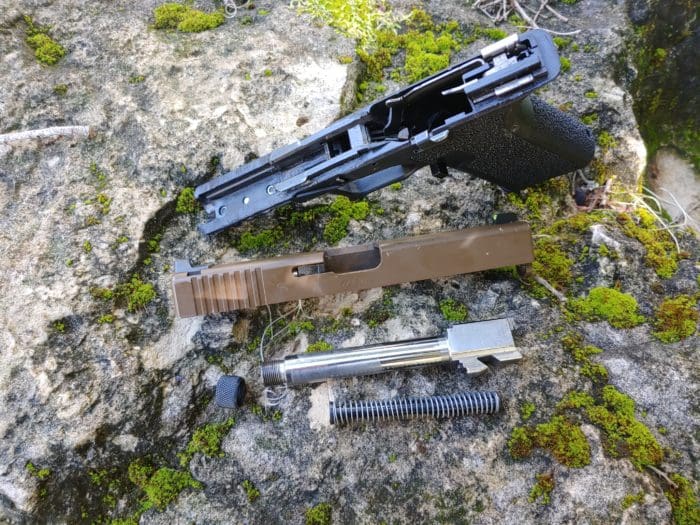
The slide is a Vickers edition model. When shopping for slides, my LGS had this one sitting in the counter and it was complete, except for the barrel. Because it lacked a barrel it lost some of the Vickers Edition collector’s value and was priced below a standard GLOCK complete slide.
What sold me on this slide was the sights. The front is an Ameriglo I-Dot Pro and the rear is a Wilson Combat Battlesight U notch sight.
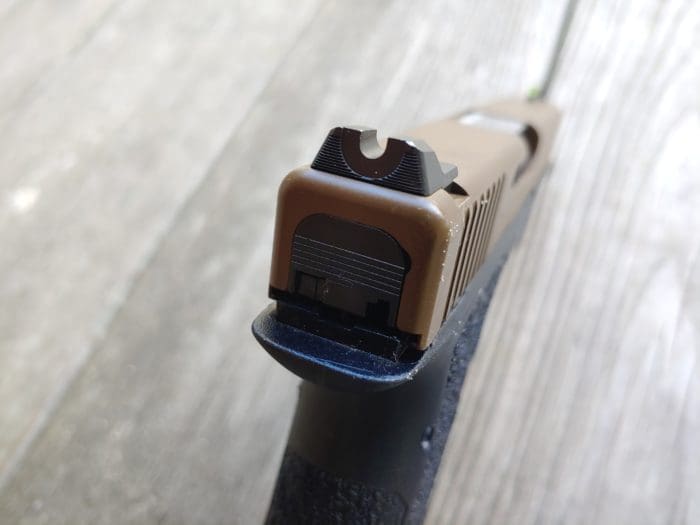
This front and rear sight combination is excellent and I’m looking to start swapping over most of my sights to this combination in the near future.
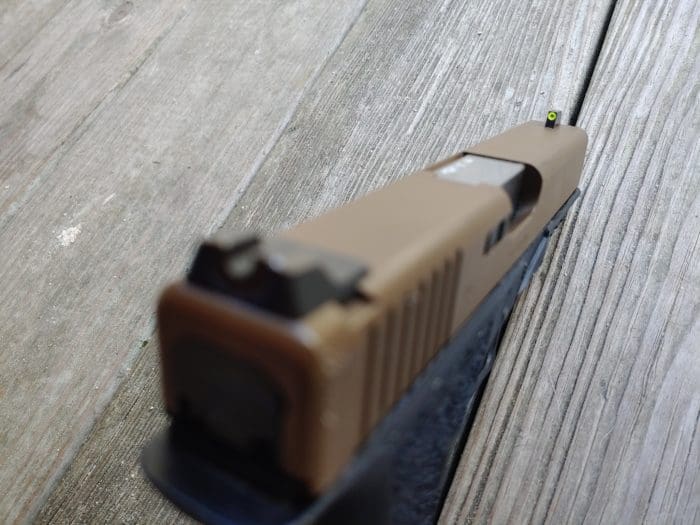
How It All Comes Together
The trial and error when it comes to a Polymer 80 GLOCK is in the final fitting, but there are a few ways to make this a bit easier. The first is, after you’ve done the rough fitting and installed the lower parts, slap the slide on and run it back and forth a few hundred times.
I put in some headphones, watched some Netflix and worked the slide in sets of 50. I ran it 300 hundred times the first night.
The first range trip showed…I had a very accurate single-shot pistol. The gun would fail to fully eject the round. Back to the workbench armed with a file and some fine grit sandpaper.
I repeated this two more times with a hundred slide racks after each filing session. After that, I had a fully functioning, semi-automatic Polymer 80 GLOCK.
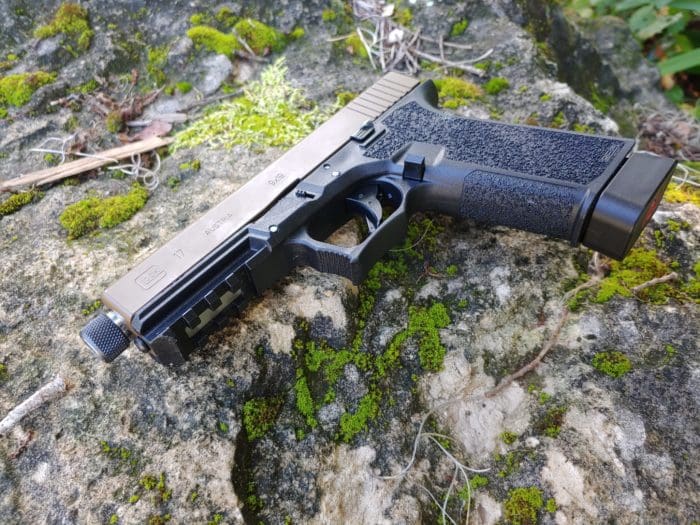
There are some major differences between the Polymer 80 GLOCK frames and standard GLOCKs to be aware of. The first is the proper Picatinny rail with multiple slots.
Another difference is the grip. It lacks the finger grooves of the Gen 3 and 4 models and the grip angle mimics that of a 1911. The final difference is the extension over the rear of the gun. It’s a beavertail — more or less — at least by GLOCK standards.
As a guy with big hands, I tend to get a lot of slide bite when it comes to GLOCK pistols. The PF940v2 leaves my hands unmarked, even when shooting with the highest of grips.
Overall, the Polymer 80 grip and frame is much more comfortable to me than a standard GLOCK frame. It points better for me and feels more controllable when it comes to recoil management.
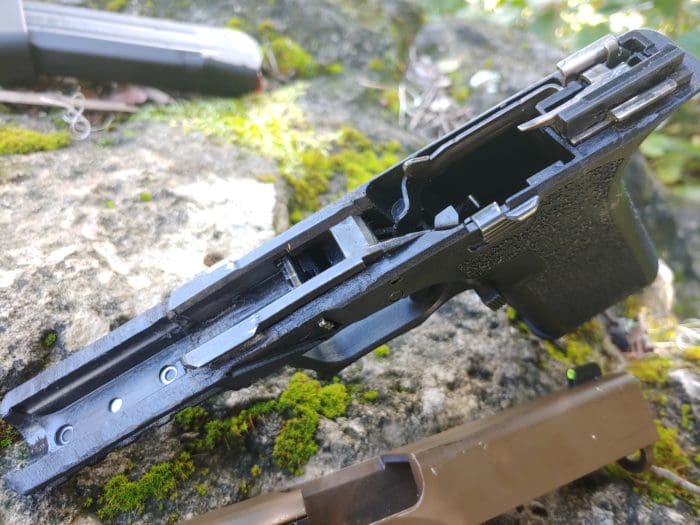
The PF940v2 runs reliably with every magazine I’ve put through it to include GLOCK OEM, Amend2, ETS Mags, Magpul, and KCI magazines as well. That includes that big ridiculous 50-round drum mag we all know and love.
After my initial break-in process, the gun has run without issue. It short, it runs like a GLOCK should. It even eats up that dirty, dry Winchester American Steel ammo.

The combination of Wilson and Ameriglo sights make it quick and easy to get on target. The high visibility front sight is quick to find and easy to focus on. It makes it easy to be both quick and precise.
The overall accuracy of the gun is impressive and I can scoot out to 50 yards and still put fist-sized groups into the chest of a man-sized target in a standing position.
The Downside
The downside in this project is that I’m no gunsmith and I’m not trusting my skills with a Dremel. Even as well as this gun runs, I don’t want to count on it. As a result, this gun is a range toy just because I don’t trust a gun that I built myself with my life.
I prefer my guns built by professionals. You may very well think differently. My Polymer 80 GLOCK performs, but I can’t quite trust myself to carry it. Yet.
Specifications: Polymer 80 Frame only
Caliber – 9mm, 40 S&W, .357 SIG
GLOCK Compatibility – Gen 3 Models Only
Capacity – Varies…10 to 50 rounds
Colors – Black, FDE, Blue Titanium, OD Green, Cobalt
MSRP – $160
Ratings (Out of 5 Stars):
Ergonomics * * * *
The Polymer 80 frame does a good job of improving upon the GLOCK’s ergonomics. The grip angle is better, the lack of finger grooves are a nice touch. (Thankfully Gen5 GLOCKs dumped them, too.) The slight beavertail is a drastic improvement as well, at least for my big mitts.
Customization * * * *
It’s still a GLOCK so there are tons of different options for customization. You can make this thing a rifle if you want, too. The only reason it gets only 4 stars instead of 5 is because you are limited to Gen 3 parts. More and more parts these days are being focused to Gen 4 and 5 guns.
Reliability * * *
How do you judge a gun’s reliability? Especially one you’ve built yourself. If I judged it from the first 100 rounds it would be a 0, if I judged it from the last 100 rounds it would be a full 5 stars. So we sit at 3 stars as an overall average. For now.
Overall * * * * *
I loved building this thing. It was a fun project that I enjoyed from beginning to end. I plan to do it again with their new hybrid build that accommodates a Glock 17 slide with a G19-sized frame. The sense of accomplishment is well worth the price of admission.

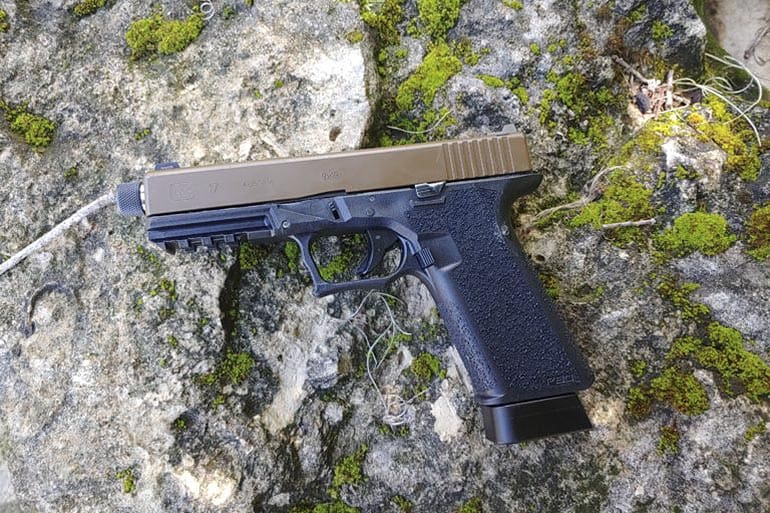
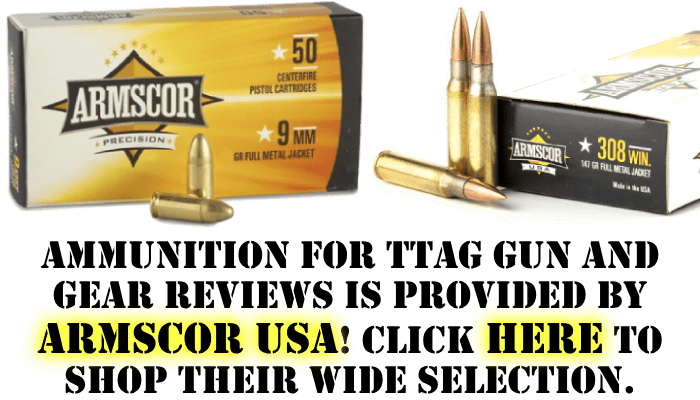



Now that you’ve run a few hundred rounds through it the gun is proven reliable. To compare it to the new build state isn’t justified IMHO.
I like the different grip.angle. it addresses my biggest complaint with Glocks. I’d like to see other 80 percent kits in different manufacturers..
That would be really cool. The more kits the better. Avoid privacy invasions and nazi like registration.
Built half a dozen of these in all three major frame sizes. Two went together perfectly with no hitches, while the others required a little fit-and-finish to get things to move smoothly. My G17s are my go-to guns. Love ’em and heartily recommend them to anyone.
Yes, you will pay more overall to complete a P80 project as compared to a factory Glock, but the opportunity to (1) completely know how a Glock operates on an armorer’s level and (2) have something that was never on any FFL book or government radar is priceless. And here in CA where the Sacramento Gestapo is looking for any way to go after your guns, that’s worth its weight in gold.
BTW, my P80 G17 has been my gun of choice whenever I attend gun courses. The instructors not only approve them during weapons check, they always give a hearty thumbs up because they know there’s a good chance I know my gun better than most of the other students know theirs.
How much total did you spend on a completed P80 build? I believe, in order to do a polymer build in CA legally, it has to be made into a single action pistol. I ended up buying a glock, g19 gen3, with frame mods, slide milling and vortex viper it totaled at $875. It was fun making a custom gun.
https://everydaycarry.com/posts/35586/home-carry-edc
You’re thinking about the single-shot exemption 1.0, but that is no longer an option.
To build an ‘off roster’ pistol, it must be single-shot only (incapable of taking a magazine) and submitted to the CA DOJ for a serial number. Also polymer frames must include a 3.5 oz plate/chunk of stainless steel – so it can’t be hidden from metal detectors.
Nate’s mention of the single-shot option was a hot topic for a few years. I’ve read legal arguments from attorneys on both sides of the issue, explaining either why it *was* or *was not* a proper legal requirement. Most people chose to end their arguments by erring on the side of caution due to ill-informed LE and suggesting that a pistol be initially built as a single-shot (with photos taken for proof) before then legally converting to a standard semi-auto configuration. All debates were based on the minutiae of our ever-confusing penal code’s wording.
The door has unfortunately closed in CA as of July 1, 2018 for building your own guns privately. You now have to apply to CADOJ for their approval and an assigned serial number which must be engraved to the frame per ATF manufacturer standards. Though the CADOJ has stated that this does not constitute registration, we all know it’s laughable on its face because of course it is.
Fortunately for me, all my builds were well before the cutoff date, and I had some of them properly engraved to comply with state law. The others remain disassembled at the bottom of my gun safe until either (1) I move out of CA permanently, (2) the laws are struck down, or (3) society here collapses from a pandemic/meteor/EMP and nobody gives a hoot anymore.
However…many people here simply continue to build.
Glad to see you are up to date on the intricacies of the California “build your own” gun laws, because they have become a byzantine trap for the unwary. California has gone out of its way to attempt to eliminate “ghost guns,” and the penalty for failing to comply with the new laws are egregious. I built a polymer lower for an AR for the fun of it and to thumb my nose at then Senator DeLeon, but after the laws started to change, I dumped it for a serialized lower. Not only is there a criminal liability, an additional consequence of getting caught with an unregistered rifle is loss of professional licenses for committing “crimes of moral turpitude.” I ain’t rich enough to “retire.”
Nice write-up. I have considered a 80% polymer builds but kept getting mixed reviews on them. your write up makes it sound like its more about the time and energy put into it to make it right than just grind it out and throw it together. I may have found a good winter project. Thanks. (Shame it’s a Glock build, a 92 or 1911 is more my style.)
A video I watched about a 1911 build demonstrated the need to buy not just the kit–which is hardly any savings–but a few specialized tools needed to complete the job that you cannot do without. One of the tools, for example, is for the press fitting of the two posts that hold in the bar that holds the spring for the take down pin and the manual safety. Another is the special tool needed to cut the rails. You end up spending $1200 to $1400 to build a $700 pistol, by my scratch pad math, and it only gets to be less if you plan on building more than one.
I was originally considering a 1911 build, as I grew up with 1911s and previously swore I’d never touch a “silly plastic gun”. But when I saw that I could build a P80 Glock for half the price of a typical 1911 build kit. I tried one, and was hooked.
If I lived in a free country, I’d build me a G20, maybe even a long slide version. Sadly CA doesn’t believe that it’s subjects can handle that.
I have a G17 and G26 (9mm) Polymer 80 builds. They not only work very well, but I like the grip angle and “beavertail” better than stock Glock. I’ve put several thousand rounds total through them so far, and they gobble up every type of ammo I’ve fed them, whether cheap steel case Tul-Ammo (as a test), quality brass Federal or Winchester target ball, or defense JHP. Never a problem with either of them. Contrary to the author’s final comment above, I myself would rely on these to protect myself, though YMMV on your own builds due to your skill level.
If you are so inclined, I recommend you build at least one. Same premise as why you’d build an AR.
Hmmm.
Might just have to build one of these for fun.
You should before the antis put a stop to it. I believe In Komifornca 80% receivers must be numbered.
Check out fullconceal.com.
They do have an 80% that is converted to the folding design
With any new gun the thing to do after buying it or building it is put a pile of ammo thru it. For a semi-auto pistol buy the cheap stuff, strictly FMJ for exercising you and the gun. If you want to save the brass for reloading, well buy brass cased then. Otherwise, consider aluminum cased, that can be real cheap.
Quality self defense (hollow points!) ammo is not cheap. You will need to train with it but you do not need to break in your gun with it.
Of course if you’ve more money than you know what to do with and can afford to train with top dollar wack-the-bad-guy bullets, please send me some!!! 🙂
A question for those that have built one –
Polymer 80 expressly says *not* to drill the 3mm and 4mm ‘pin’ holes using a drill press, but to use a hand drill.
Don’t you want the straightness of a drill press so the holes are perfectly straight all the way through the frame?
That just doesn’t make sense to me…
EDIT –
I’m not planning on drilling all the way through it in one shot, just each side. Drill one, flip the jig, drill the other…
Yeah, I noticed that in their instructions, but I don’t have a drill press at home so it didn’t matter to me. I used a Dremel with a sanding wheel (to remove the tabs), a cordless drill (for the pin holes), and a box cutter with a new blade (to remove the final bits of the tabs and make the frame guides perfectly smooth without any need to sand). That’s it. All my frames turned out even nicer than the ones on any of the instructional vids out there. Each build took me about two hours from start to finish, and that’s including the lower parts installation and final fit-and-finish.
Funny thing…now that I’ve built several of these and love ’em, I find that I prefer them over full factory Glock frames. The mini Picatinni rail holds my Olight perfectly. Nice and tight.
Interesting article. I’ve heard about 80% Glock frames. I wondered how they could be built.
My son and I built a PC for my son. We could have just bought one but here we controlled how it would look and work. It looks exactly how my son wants it to and works perfectly because I used top tier and high value parts. Any compromises are ones we did. Shop brand PCs are designed for high margins for the vendor. They sometimes might have a decent CPU, if you paid the premium, but they typically have cheap and barely adequate power supply, low end video hardware, not much storage, and awful screens. In my son’s PC all these faults were fixed at less than the cost of high end shop PC.
you couldn’t get your build combat trustworthy.
Brownells has put the Glock P80s on sale in Novemberish in the past.
And their cheap slides work ok.
Problems:
OEM Glock lower parts fixed my trigger reset. Lots of videos out there showing this issue. Nothing fixed it til I went to OEM.
I received a misdrilled P80 metal bracket in my kit and took some pics and sent the pics into P80 and got a new one promptly. Good service/ support.
CA compliant 10 round mags don’t work reliably on my P80 G19. I just bought full size.
Unless you bought it using cash, then every Fed that can run your financials can access to your credit card can know you have it, and your other firearms. And if you ever bought from a now-closed dealer, then all the records for that cash transaction belong to the ATF. And if you ever bought any parts, holsters, etc, then they know you are a gun owner. And a corrupted Fed will be able to shut individuals down economically if they wish. Our safety is not in individual anonymity, but in numbers of the law-abiding, peaceful armed militia.
So, build it to learn, for fun, and for personal satisfaction! Enjoy.
I did a drill press on my G19 P80 holes and it worked fine. I used a 2 axis vice & drill press for milling for precise cutting but you don’t need that.
I am now drilling the next holes on the G20 (45 acp) w/o a press. This seems to be equivalent to a Gen 3 G20. Seemed to work fine.
I built the upper from scratch. You need a channel liner tool if you buy a slide and do it from scratch.
You’ll need some way of putting on the sights, e.g. a sight tool.
And I used a pin removal tool for removing the pins because you assemble and reassemble it a bit.
Many just buy a complete upper to avoid this issue.
The parts that you use must be for Gen 3. The GlockStore, ironically in San Diego seems to be disassembling Gen3 Glocks and parting them out so they are a nice source of OEM parts and apparently a bit more profit than the OEM Glock. GlockStore barrels show a lot of wear quickly. Buy the OEM parts from them.
Agreed. I built all my P80s with full OEM Glock parts kits. Trigger, barrel, slide, everything. Kits are easily available on eBay (for now, before they go full woketard). The only aftermarket upgrade I did was steel and/or tritium sights.
80% frames and receivers are not firearms due to regulations, not law. ATF picked 80% as the limit, and they can change the regs by fiat to be 50% or 99%.
If you bought it with a credit card, the government already knows you have it.
Knows you HAD it. Of course, their knowledge is illegal. But we have found with SpyGate that that hasn’t slowed the Feds down. I would move to suppress based on violation of 4th and 5th Amdts, and make them prove the source of their information in court. Probably won’t work but there is a chance if you have a properly suspicious judge, like Gen Flynn seems to have with Federal District Court Judge Emmet G. Sullivan.
My point with “had” is that the way around this is to have one purchaser for multiple people. Since 80% complete lowers are not legally firearms yet, there is absolutely nothing the least bit illegal about reselling them or acting like a straw purchasers, etc, under Federal law. State laws, like those mentioned for CA may be relevant. Mostly though, I think that you need to be careful not to be considered in the business of reselling 80% lowers, and thus be subject to state and local sales tax, etc.
Vendors make this easy – some sell 80% lowers in 5 packs.
Make sure the recipient receives the original, unmodified P80, then does all the work on it. It’s a great father / son and or daughter gift for a Christmas present that can bring you memories together and develop and aptitude and talent in your child that will help set them apart from their couch/TV/video game peers. Treat it the same as a lower once you are done. And never ever sell it.
If your child makes a mistake and ruins the lower, my understanding is that P80 has been known to give you a cut rate on a brand-new one if you slice the old one in half and send the halves back (?).
And plan on this becoming illegal sometime in the near future.
Some websites occasionally run specials where you can get a full kit for under $400.
That said, you still have to register this pistol in NY to avoid being a felon, so, might as well just buy a real Glock brand glock.
After purchasing or building a new gun, the first thing you should do is run a bunch of ammo through it. Buy the cheapest semi-auto pistol you can find and only use FMJ ammunition to practise with. If you want to save the brass for reloading, buy it cased. Otherwise, consider aluminium cased, which can be very inexpensive.
Excellent self-defense (hollow points!) Ammunition is not cheap. You will need to practise with it, but you will not need to break in your gun.
Of course, if you have more money than you can handle and can afford to train with top dollar wack-the-bad-guy bullets, please send me some!!!
How much did you spend on a finished P80 build? I believe that in order to do a polymer build legally in California, it must be a single action pistol. I ended up purchasing a Glock, G19 gen3, with frame mods, slide milling, and a Vortex viper for $875. Making a custom gun was a lot of fun.
P80 Order shorted me two frames. This was 4 months ago. Tried to call and spoke with CS. Eventually asked for refund. Buyer beware. Great article and review. Wish I’ve received my frames. Thanks.